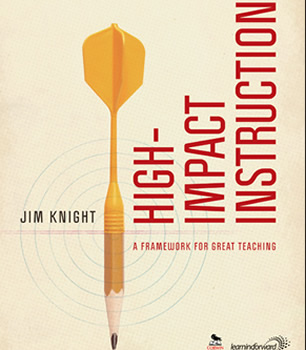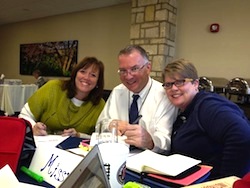The Educator’s Bible
High-Impact Instruction: A Framework for Great Teaching
by Jim Knight
(Corwin, 2013 – Learn more)

Jim Knight is a teacher’s teacher. His goal is my goal, that my instruction will have the highest impact on learning possible. He wrote this book for those of us in the classroom, for our coaches, our principals, and our students. He wrote this book after learning from researchers, from his own and others’ experiences and observations, and — importantly — after learning from teachers in classrooms around the world. Those teachers’ voices are literally peppered throughout the book by Quick Response (QR) codes that link to dozens of video clips.
There are several things I especially appreciate about this book. First is Knight’s constant respect for what we do each day and his sincere desire to support our work. He writes:
“The most important factor in the classroom is not techniques, strategies, and principles. It is the committed teacher, whose mind and heart are dedicated to doing what it takes to make a difference, to reach more children, to teach in a way that has an unmistakable positive impact on the lives of the children. This book is meant to honor teachers.” (348).
Jim Knight not only honors us with his book, he provides supports and instructional practices to help us “think deeply” about our current practices. This book most often felt like a conversation, but never a lecture.
Second, there is an entire chapter devoted to the power of effective stories. I believe in the power of stories because I have witnessed it, but few professional books include stories as an instructional practice. Knight acknowledges this narrative power and has presented research and new information that will improve the effectiveness of stories in my classroom.
A wonderfully organized book
Third, the organization of each chapter of the book is effective for me as a learner. Chapters start with a learning map and an effective quote. Within chapters are checklists to clarify how the high-impact teaching practices should be implemented. Surveys and other resources are also highlighted in chapters and available at the book’s companion website to download.
At the end of each chapter is a “Turning Ideas Into Action” section (with a focus on students, teachers, instructional coaches, and principals) that clarifies what the instructional practice looks like in action. Also, each chapter‘s main points are summarized and we are provided with more resources for continued investigation of the topic in a section entitled “Going Deeper.”
The instructional strategies presented in this book are organized around four themes: instruction, content planning, formative assessment and community building. The use of these strategies should help all of us reach more of our students. Listing the chapters found under each theme will give you an idea of the strategies found in this book.
Planning: guiding questions, formative assessment, learning maps.
Instruction: thinking prompts, effective questions, stories, cooperative learning, and authentic learning.
Community Building: learner-friendly culture; power with, not power over; freedom within form; expectations; witness to good; fluent corrections.
I plan to investigate David Neils’ International Telementor Program (ITP) that is mentioned in the authentic learning chapter. I feel this program can support my students with their project based learning (PBL). After experiencing the learning maps found in each chapter, I realize the power of learning maps and will be rereading that chapter and creating them.
An investment in your career
High Impact Instruction is a book that will be at your desk, flagged with post-it strips (as mine is now). This is a book you’ll be reluctant to lend out because you’ll want to reread sections as you plan lessons. This is a book you won’t “get” all at once. At 371 pages, it covers more than you can digest with a “once over” reading. This book is an investment in your professional career.
The instructional practices found in this book will make a difference for our diverse student population. I believe Jim Knight has met his stated goal for High Impact Instruction:
…to make sure that teachers know there is hope, that there are practices that can make a difference, and if teachers commit to learning, experimenting, and mastering these practices, if they strive for personal best, they will feel the joy of learning, and so will their students.(348)
Julie Dermody, NBCT, is currently an ESL teacher in the Chapel Hill-Carrboro (NC) City Schools. She has also served as an elementary, middle and high school teacher, a reading specialist and a teacher of gifted students. Her article about ESL students, “Going for the Growth,” appeared in the September 2012 Educational Leadership (online edition). She will be presenting at the TESOL International Convention March 2013 in Dallas, Texas.




































I just began working with David Neils and the International Telementor program this semester and it has been an amazing experience! My students are learning some truly remarkable things (and we’ve only just started!) and my learning steep learning curve has rejuvenated my 20-year-old teaching career! I recommend ITP whole-heartedly!
Hi Julie, Thank you so much for your kind words. After putting so much time into writing this book, it is really gratifying to read such a generous review. I really appreciate you taking the time to write this.
This may be a book I would like to get for my daughter studying Elementary Education for K-6 and will be student teaching in August 2013. Does this apply to all grades?
Thank you.
Yes, this book does apply to all grade levels. I’ve taught K – 12th grades
throughout my career and this is a book that I could use at any of those
grade levels. Currently, I’m using it with my 1st, 2nd and 5th grade students.
Plus, your daughter will appreciate the QR links to videos that show teachers in action
and / or talking about teaching practices. You can watch them on your phone or tablet!